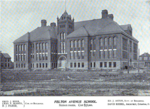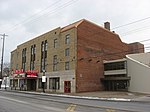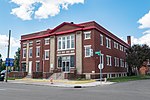King Arts Complex
Clubhouses on the National Register of Historic Places in OhioColonial Revival architecture in OhioColumbus Register propertiesEndangered buildings in Columbus, OhioKing-Lincoln Bronzeville ... and 6 more
Knights of Pythias buildingsMemorials to Martin Luther King Jr.National Register of Historic Places in Columbus, OhioTheatres completed in 1925Theatres in Columbus, OhioTheatres on the National Register of Historic Places in Ohio

The Martin Luther King Jr. Performing and Cultural Arts Complex is a historic building in the King-Lincoln Bronzeville neighborhood of Columbus, Ohio. It was built in 1925 as the Pythian Temple and James Pythian Theater, and was added to the National Register of Historic Places and Columbus Register of Historic Properties in 1983. The building was renovated into the King Arts Complex in 1987, and was vacated in 2019. Community leaders restored the building's use as an arts center in 2021.
Excerpt from the Wikipedia article King Arts Complex (License: CC BY-SA 3.0, Authors, Images).King Arts Complex
Mount Vernon Avenue, Columbus Near East Side
Geographical coordinates (GPS) Address Nearby Places Show on map
Geographical coordinates (GPS)
| Latitude | Longitude |
|---|---|
| N 39.971111111111 ° | E -82.978888888889 ° |
Address
Mount Vernon Avenue 867
43203 Columbus, Near East Side
Ohio, United States
Open on Google Maps










